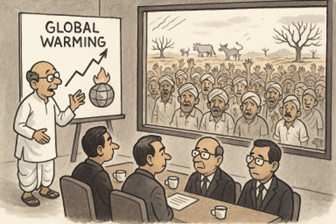



Climate change is no longer a distant storyline. In 2024–25, its tangibles—searing heat, flooded villages, parched farms—have struck at our doorsteps. Despite the shifting global consensus under pressure, we cannot wait for others to lead. India must define its own path, with urgency, unity, and locally driven solutions.
Agriculture is not just an economic sector—it is our food, our culture, our people. Rural India must be empowered, water must be treated as life, and the policies we set now will ripple for generations. The time is now—not for moonshots, but for groundwork: resilient, green, rooted.
Global Contradictions: Waiting for Whom?
Even as India reels under unprecedented weather extremes, global leadership looks elsewhere. In Washington, President Donald Trump has pressed the World Bank to finance more fossil-fuel power plants, rolling back years of climate consensus. Allies have responded with little more than cautionary murmurs. At the very moment the world needs collective urgency, the largest economies are preoccupied with energy politics, not planetary survival.
For India, this is a dangerous distraction. Climate change is not a Western villain in a Hollywood script—it is at our doors in Himachal, Kashmir, Punjab, Assam, Tamil Nadu. The floods and droughts of 2024 made it clear: we cannot afford to wait for the world to escape its political spells.
The Indian Reality: A Twilight in Agriculture
Setting Our Own Agenda
India must stop looking outward for permission to act. We have the resources, we have the urgency, and we must set our own climate agenda.
With 7,000 km of coastline, India should build a network of desalination plants, modelled on Israel and Saudi Arabia. These plants should not add to our carbon burden: they must run on solar and wind farms—energy sources India is abundantly gifted with. Every drought-hit district should be able to draw water from a renewable-powered coastal grid.
Alongside the Army that guards our borders, India should create a Green Army to safeguard food and water. Recruited from rural youth, they would be trained with the discipline, physique, and regimentation of soldiers—only their battlefield is climate.
Their duties:
This Green Army would simultaneously provide employment, resilience, and development—turning rural despair into opportunity.
India spends lavishly on metro lines, high-rise skylines, and urban beautification, often at the cost of rural neglect. For once, let us direct national investment toward the crisis at our doorsteps: water, food, and farming. Urban glamour cannot feed a hungry nation.
Conclusion
Agriculture has been India’s backbone for millennia. Today, it bends under the twin pressures of climate change and neglect. If left unattended, food security itself could enter its twilight.
But we are not powerless. We can build desalination grids, harness our sun and wind, train a Green Army, and secure rural India with fresh thinking. We can spend not on moon missions or fashion-driven urban projects, but on the lifeblood of our people: food, water, resilience.
The clock is ticking. India must act—not tomorrow, not after another summit, but today.